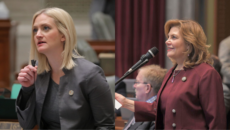Editorial Note: This is part 2 of a 3-part series on the congressional redistricting process. To read part 1, click here.
As the map making process moved across the rotunda, Senate redistricting chair Sen. Mike Bernskoetter, R-Jefferson City, chose to hear the map and exec it out on the same day, making no changes.
“There were never going to be changes made in committee. It was a total sham,” Eigel said. “It was also clear the moderates were drawing the lines of battle to resist both a 7-1 map and work towards a map that they felt would politically harm some of the members of the conservative caucus. It was really unfortunate that was their objective,” he added.
Presenting the House’s Map
Shaul’s initial presentation of his bill was uneventful. However, when it came time for the senators from St. Charles County to question him, many felt that the representative became combative.
“If you are going to carry big legislation, it’s a good idea to be familiar with it before a hearing on the other side of the building,” Eigel said. “Shaul couldn’t answer basic questions on his map about compactness, map logic, Republican lean—and then simply said things ‘shouldn’t be political’ when pressed further.”
“It was like watching Mark McGwire plead the 5th before Congress when asked about steroid use. No one did more damage to Shaul’s original House map than Shaul himself did with that performance — What a mess,” Eigel added.
Shaul felt as though he was being set-up by the two Senators questioning him and chose to limit his answers.
“They were asking me to speak on the political gerrymandering or the political numbers. Our purpose in our committee, and the General Assembly, is to draw maps in the state of Missouri that fits the state of Missouri, not based on political numbers,” Shaul said.
“I wasn’t going to go down that rabbit hole with them. They had an agenda in that meeting. It was very clear. And when I remained calm, and refused to go down the rabbit hole that they had pre-established… I mean, it was just very clear what their purpose was in that meeting,” he added.
The hearing went so poorly some speculated that it had a role in the decision to use the discharge petition on the final bill instead of going back through the Senate Redistricting Committee. While the Senate hearing was a long day for Shaul, he would be redeemed in the ensuing weeks as it became clear that no one could produce a map that everyone could agree on.
The hearing would see testimony from Susan Klein, the head of Missouri Right to Life, where she would again prove her status as the leader of the most influential interest group in the Capitol. She made the case for the 7-1 map, and would begin a campaign of encouraging her supporters to join the 7-1 map fight.
She would be followed by a literal witch, and a couple people who said they had spoken to deceased relatives and had premonitions to share with the committee. The bizarre end to the meeting was a harbinger of things to come.
One Senator, who remained anonymous and was on the redistricting committee, saw the hearing as a waste of time.
“The Senate hearing devolved into the shit-show we all knew was coming, but this was a Broadway play level shit-show instead of the community theater level shit-show we were prepared for,” they said.
As the bill was moved to the calendar, the redistricting issue was brought up in the Republican caucus meetings for the first of what would be several times. It became clear that the nearly the entire caucus was willing to let the map go to a vote, which would have seen its passage — except for the conservative caucus.
“The moderates never really accepted the motivations of the conservative caucus. We wanted a 7-1 map. When that was opposed, we pushed for a 6-2 map that would have passed the chamber with more than 20 votes and addressed a variety of concerns we had,” Eigel said.
During the ensuing weeks Sen. Andrew Koenig, R-Kirkwood, drew several dozen maps attempting to bring the warring elements of the party together, to no avail.
“Yes, St Charles, but also strengthening CD2, combining the military bases, Taney County, and Webster County…We compromised on a long list of items relative to all these things. But a small knot of folks in the Republican Caucus didn’t want to take yes for an answer,” Eigel said. “So the result was a protracted fight that ultimately produced a map that had much room for improvement.”
One republican Senator, who remained anonymous, was for allowing the map to go to a vote, but did give credit to the conservative caucus for its knowledge of the issues surrounding the map.
“The conservative caucus really did know more about the map details than anyone else, but it wasn’t because they were Magellan or anything, its because they were the only ones mad about the map.” they said. “It wasn’t the first time they were the only ones mad about something, and therefore cared more than anyone else about the map.”
In Eigel’s view, the conservative caucus was ignored and shut out of the decision making process.
“We put a lot of effort into knowing the numbers and case law—and we presented that info multiple times in caucus before we got to the Senate floor,” Eigel said. “But it didn’t matter. The numbers were on our side for everything from a 7-1 map to combining big counties—but objectively speaking, none of it mattered.”
31 Hours
There are two parts to passing a bill. The easy part: passing the House, and getting a Senate committee to move the bill to the Senate informal calendar. Then the hard part: perfecting a bill on the Senate floor.
It was clear that there would be a filibuster of the bill on the Senate floor, but no one knew how long it would go.
The filibuster started hotly with Onder calling the house map a “Pelosi” map, a “sellout” map, a “pro-abortion” map and a “5-3” map.
It wasn’t long into the filibuster that Onder began asking for repeated quorum calls to harass the rest of the Senate into being unable to sleep, forcing them to return to the floor.
The conservative caucus found an unlikely ally in another Senator wanting to run for Congress, Sen. Steve Roberts, D-St. Louis.
Roberts wanted changes to the first district to cut some white liberal communities and add African-American areas and Jewish neighborhoods to the district.
Roberts was an easy ally for the caucus to make, despite ideological differences. The Republican caucus didn’t see the first district as a priority, as it was protected under the Voting Rights Act.
Roberts, the Minority Caucus whip, was able to orchestrate Democrats into holding the floor for hours. Democrats filibustered despite the fact the House map they were filibustering protected Democratic Congressman Emmanuel Cleaver’s fifth district.
The filibuster went 31 hours. Ultimately it became difficult to keep a quorum, and the map had to be laid over.
“This was a turning point not just in the redistricting process, but in the Senate process itself. Ever since the General Motors debate, it was felt enough floor time would cow a small group of determined Senators. But this time, a group of Republicans and Democrats pushed the floor beyond the reach of the majority,” Eigel said.
“By the second morning, one shift of the filibustering senators were fresh and rested, and the majority was exhausted from constant quorum calls and being up all night.”
Eigel felt that the filibuster was effective in breaking down the opposing Senators and building up public support for the conservative caucus.
“When we took them to 31 hours two things became clear: one, that the public was increasing its support for our position of a 7-1 map, and, two, the longer it went, the stronger we were getting while weakening the physical and political hand of the Republican moderates,” said Eigel.
After the grueling filibuster, the Senate stepped away from the map until the end of session.
Attempts at Progress
While the Senate stepped away from the map, the House and Koenig made repeated attempts at a compromise. One Senate staffer estimated that in three months Koenig drew about four dozen maps trying to find a compromise.
Meanwhile the House prepared another map to send over. Speaker Vescovo continued attempts at joint meetings with different combinations of legislators to try and find a compromise.
“These meetings were….an ill-conceived idea,” Eigel said . “I didn’t speak to Caleb (Rowden) about them beforehand, but I got the sense that he shared my assessment. I just know they were a total waste of time.”
“I kept trying to tell him that having that many people in the room was a bad idea, but he was determined to have the meetings so I agreed,” he added.
Rowden felt the meetings were ineffective as Vescovo, despite his best efforts, was unable to truly grasp the problems with getting a map through the Senate.
“I do think that Rob had enough one-off meetings with the conservative caucus to know there were real problems. But any speaker’s ability to understand the Senate burden is never very good.” Rowden said.
The culmination of the meetings was a gathering where four maps were placed in different corners of the room, and Vescovo asked everyone in attendance to place a piece of paper in a jar in front of them to vote for one.
“It was comical. He literally asked you to put a piece of paper in a jar in front of the map you liked. What a strange affair that was,” Eigel said.
Eigel and Onder, instead of voting for a map, made their demands once again known to Vescovo.
“He asked us what we wanted and Sen. Onder and I said we wanted a 7-1 map… When that was once again rejected, we offered a strong version of 6-2 where Donald Trump would have won CD2 by 12% (in 2020). Hawley would have won it by twice the margin of the final map.” Eigel said.
“Jefferson and St. Charles would have had much smaller splits than they ultimately got, about a dozen other concerns from both the House and Senate were addressed, and we could all declare victory. But that fell on deaf ears. After that, we never heard from him again,” he addded.
Ultimately the house passed a new map that gave the conservative caucus more of what they wanted overall, but did not give them the 80/20 split of St. Charles County they were asking for.
While the Senate put the congressional map on the back burner, concerns turned to the budget and the supplemental appropriation bill that included the bulk of the federal money.
“We had so many concerns with these budgets that it could have taken the entire summer to address them,” Eigel said.
Senate Appropriation committee leaders Sen. Dan Hegemen, R-Cameron, and Sen. Lincoln Hough, R-Springfield, had approached each member of the conservative caucus on what they wanted in the budget, and acquiesced to their requests.
One Senator on the appropriation committee commented, “I was shocked that their requests were so low. It was the only actual conservative thing I’ve seen them do in four years.”
Check back tomorrow at themissouritimes.com for part 3.
















